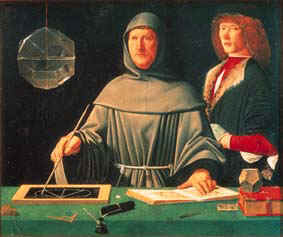 Click to enlarge in a new window |
Mathematics on the "Ritratto di FrÓ Luca Pacioli"
 Click to enlarge in a new window |
A very interesting paper about the historical and mathematical elements was published by Nick Mackinnon: "The portrait of Fra
Luca Pacioli", The Mathematical Gazette, 77 (1993) pp. 130 - 219.
The closed book on the table is supposed to be the "Summa de arithmetica geometria proportioni et proportionalita",
written by Pacioli. A regular dodecahedron is placed onto this book.
The open book is book XIII from Euclid's Elements. Pacioli clearly is exposing a theorem to one of his pupils.
Book XIII treats the Platonic solids or regular polyhedra.
The drawing on the slate occurs in proposition XIII.12, although Mackinnon mentions this drawing is also linked to other
propositions concerning the regular dodecahedron and icosahedron.
In the Museo e Gallerie di Capodimonte in Napoli (Italy) one can admire this "Ritratto
di FrÓ Luca Pacioli".
The only thing that is certain is that the central person
is FrÓ Luca Pacioli, one of the most famous mathematicians
from the Renaissance period. The painter is unknown, although some people are convinced the painter is
Jacopo de' Barbari. Other people think that the painting isn't the work of one artist. As to the other person on the
painting, some people suppose it's Guidobaldo, Duke of Urbino, other people are convinced it's the famous painter
Albrecht DŘrer.
The rhombicuboctahedron on the "Ritratto di FrÓ Luca Pacioli"
 Click to enlarge |
However, the RCO on the painting has a different orientation. This orientation easily can be derived by viewing the object from the right side. The diagonals of the square in the centre are horizontally en vertically oriented as can be seen from the level of the water. This is a valuable help to determine the point on the upper triangle where the suspension string has been attached. |
 |